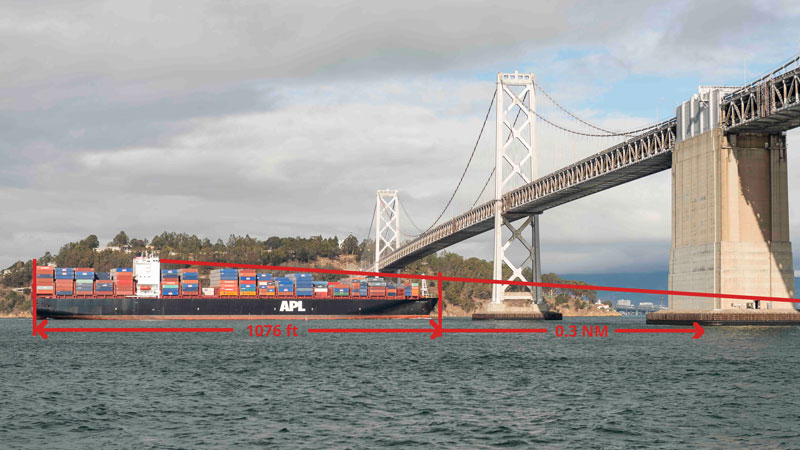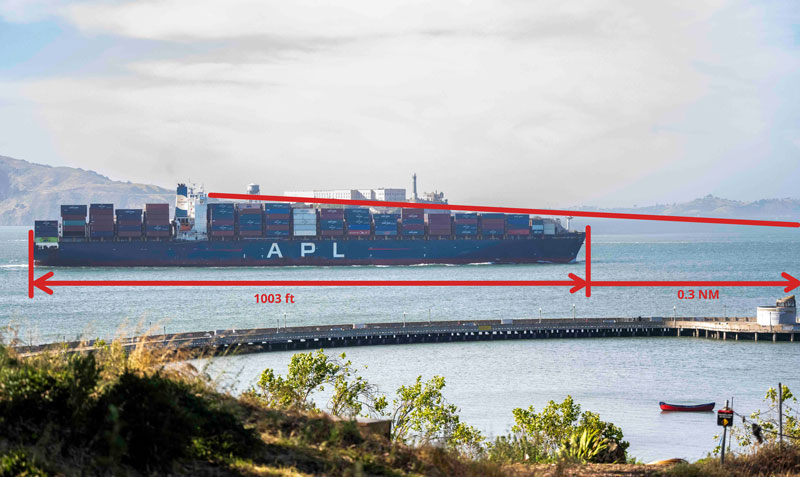
On Rule 9 and Large Ships
Everyone boating on San Francisco Bay must obey the US Inland Waterway Rules under federal law (33 CFR §83). As the Coast Guard says, “The Rules are legally binding and application of them makes the waterways safer for everyone.” Some important ones are:
- Rule 9(b): A vessel of less than 20 meters in length or a sailing vessel shall not impede the passage of a vessel which can safely navigate only within a narrow channel or fairway.
- Rule 9(d): A vessel shall not cross a narrow channel or fairway if such crossing impedes the passage of a vessel which can safely navigate only within that channel or fairway. The latter vessel shall use the signal prescribed in Rule 34(d) [at least five short and rapid blasts] if in doubt as to the intention of the crossing vessel.
One challenge on San Francisco Bay is the prevalence of large ships that have limited maneuverability and must stay in restricted channels. Look at a chart and you’ll see those traffic separation lanes and channels cover a good part of the Bay.
Big ships have a lot of windage above the waterline and a lot of current-catching hull below it, so they need speed to steer with their rudder. Ships come through the Bay at 10-15 knots. That’s 0.25 nautical miles per minute.


Putting that together, if you are 0.6 miles from the bow of a container ship, the pilot has one minute to confirm you’ve gotten out of the way safely before they can no longer see you. That can make them understandably edgy around sailboats, and they may start blasting five sounds sooner rather than later.
With an emergency reverse — which is a last-resort maneuver — the S.F. Bay Bar Pilots Association says a big ship can still take 2 miles to stop. This further extends the distance ahead the container ship pilot wants to know you’ll be out of the way.
Much as a close crossing in sailboat racing feels much safer if you know the other boat sees you, the pilot can find it reassuring to know that you’ve seen the ship and you are working to immediately get out of the channel they have to stay in. In the case of a ship, that means radio contact. If you think a ship pilot could be at all concerned about you, be ready to respond promptly to a hail on VHF 16.
If you’ve raced enough, you’ve heard about or seen plenty of collisions between highly maneuverable sailboats when someone did not see the other boat or misjudged a duck. Between sailboats, a collision usually results in a protest and repairable damage. But when a ship is involved, it’ll be a fatality.
So if you hear a ship blowing five blasts and you think, “That cannot be me; I’m at least a half mile away,” it might well be you. Please sail responsibly, and reduce stress on ship pilots.

Excellent and possibly lifesaving information, Christine!
I’ve heard for years that the Captain of the Port of San Francisco Bay has designated pretty much the entire bay as a “narrow channel or fairway”, not just the channels indicated by buoys or the lanes marked by parallel lines on the chart. I’ve searched for the official language backing this up, and I think I found it once in the Code of Federal Regulations, but I didn’t have the patience to read and understand the long detailed description full of lat/long coordinates and compass directions. The bottom line is that it’s more than the mythical “rule of tonnage” that requires us to stay out of the way of the big ships *everywhere* on the bay.
Hopefully forgetting to mention that any ship large enough for Rule 9 to apply to won’t necessarily be on Channel 16 was just an oversight. They’re required to monitor Channel 13 and the VTS frequency thus excused from keeping a listening watch on 16.
R, the line about VHF 16 (“If you think a ship pilot could be at all concerned about you, be ready to respond promptly to a hail on VHF 16”) indicates that sailors and other recreational boaters should monitor 16, as another mariner (including bar pilots) may hail on that frequency. If you initiate a radio conversation with a ship pilot within the Bay, do so on VHF 13. I have done that in the past when it was unclear where the ship was going to go and thus where I should go to stay out of its way.
I think those ships have bow lookouts so no blind spot
Allan, here’s a response from our source regarding bow lookouts: In response to a comment above: “I think those ships have bow lookouts so no blind spot.” Part of the motivation for writing this was hearing about the blind spot from the Coast Guard after a near mishap. We asked our contact at the SF Bay Bar Pilots Association, who vetted the article, to respond. They wrote “Yes – USCG regulations require a lookout posted on the bow. But no — boaters should be very concerned about being in the blind spot, regardless of a lookout.”
In 2004, Richard Spindler wrote a story about an incident involving a car-carrier ship, a sailboat and the Richmond-San Rafael Bridge. See https://www.latitude38.com/LectronicLat/2004/0704/July12/July12.html and the resolution following an investigation: https://www.latitude38.com/LectronicLat/2004/0704/July12/July12.html